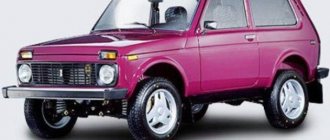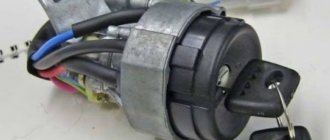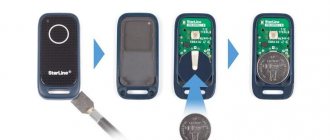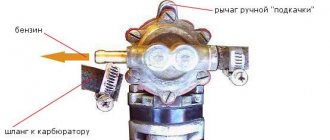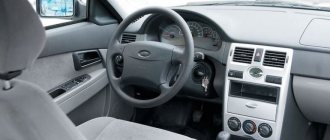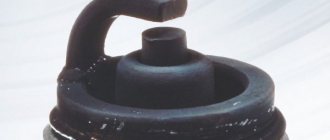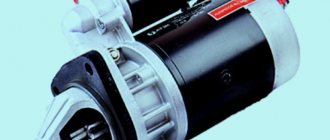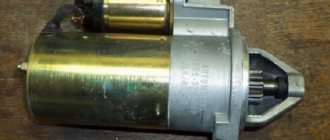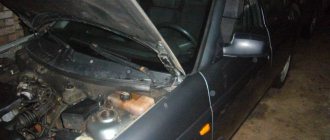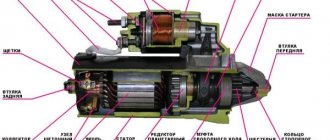How does the engine start?
The internal combustion engine only operates if the following conditions are met:
- A sufficient amount of fuel and air mixture enters the engine cylinders.
- At the right moment (and to be precise, after the air-fuel mixture is compressed), the spark plug produces a high-power spark.
- The camshaft and crankshaft rotate at the required frequency, which is strictly selected. Only in this way does the gas distribution system work correctly and the chambers are filled with a combustible mixture in a timely manner.
When the driver turns the ignition key, voltage is applied to the starter relay, thereby activating the electric motor. Its function is to engage the flywheel with the crankshaft. Then the crankshaft begins to rotate, its angular momentum is converted into reciprocating movements of the pistons.
When the cylinders begin their work, this subsequently leads to the movement of the camshaft. The latter is needed in order to promptly open the valves to fill the combustion chambers with the mixture.
Camshaft
The internal combustion engine power system is responsible for the timely delivery of the combustible mixture. As soon as the piston moves to the upper compression point, high voltage is applied to the spark. Thus, when the mixture is ignited, a small explosion is created, the expanded gas affects the piston and it moves, moving the crankshaft. We have described the principle of starting an internal combustion engine; remember that engine modifications may be different, so the starting algorithm may differ.
Operation of an internal combustion engine
The dashboard is the primary source of information
Drivers get so used to their car and often do not pay attention to the information on the instrument panel. Having turned on the ignition, take a quick look at the flashing multi-colored lights on the panel, start the engine and set off. But there comes a moment when the starter purrs cheerfully, and the engine doesn’t even sneeze. It was here that the panel blinked slyly and forced the driver to carefully examine the instruments on it with the ignition on.
The engine is cold, and the coolant temperature on the panel is already high. This is the reason for the lack of starting, associated with incorrect temperature readings, therefore, the incorrect position of the ignition timing at the moment of starting the engine, and the opening of the air bypass channel of the idle speed regulator by a certain amount.
In later releases of VAZ and Gazelle cars, temperature information on the instrument panel comes from a separate temperature sensor not connected to the control unit. And such a malfunction can be determined by installing an additional trip computer (MK).
Based on the MK readings, it is also possible to determine a synchronization fault when the crankshaft is rotated by the starter. If the synchronization sensor (crankshaft position sensor) is faulty, the tachometer will not see the rotation speed, and if the control unit “does not see” the shaft speed, it considers that the shaft is not spinning and, accordingly, does not issue switching signals to the ignition coil and fuel injectors.
On modern cars of some brands, for safety reasons, a forced start lock is provided and the seat belt indicator or the steering wheel lock indicator is on.
Not everything is so sad and if the engine does not start, then you can identify the fault without leaving the car. If the malfunction is not identified, then you need to get out of the car and open the hood.
Why does the engine not start when the starter is working?
Many drivers have more than once encountered a situation where, after turning the key, the dashboard lights up regularly, signaling the presence of fuel in the tank and sufficient battery charge, but when the key is turned to the “engine start” position, the starter, instead of a couple of revolutions, continues to hum, rotating the crankshaft, but the engine does not start.
The reasons for this problem lie in malfunctions of one or more vehicle systems responsible for the normal operation of the engine.
Fuel system
Before entering the combustion chamber, fuel passes through several components of the fuel system: tank, pump, filter, injectors and throttle body. Let's look at all these components in order.
Tank. The fuel level in the tank is measured by a special sensor equipped with a float. If this mechanism malfunctions, the arrow on the dashboard may indicate the presence of fuel when the tank is completely “dry” - the engine cannot be started without fuel.
Pump . Depending on the type of engine and the fuel consumed, the pump can be located in the tank or in the area of the engine group. Designers of injection engines equip their products with an electric pump, the operation of which can be heard in the cab when you turn the key. Carburetor engines supply fuel to mechanical pumps that operate from a central shaft drive. The reasons why the device does not supply fuel may be wear of the electric motor brushes and other parts. Failure to start a diesel engine can also occur as a result of airing of the high pressure fuel pump or a malfunction of the silencing valve.
Fuel filter. After several unsuccessful attempts to start the engine, it is worth checking the condition of the fuel filter. This component does not allow water, dirt and other foreign matter to enter the engine. Failure to replace the filter in a timely manner leads to its complete clogging and blockage of fuel.
Injectors and throttle valve . In gasoline engines, fuel is mixed with air and enters the combustion chambers as a finished mixture. The intensity of the air supply is controlled by the throttle valve, which is driven by a mechanical drive or electric motor. A malfunction of the damper may cause the engine to fail to start. To supply diesel fuel to a group of cylinders, nozzles are used - complex and expensive mechanisms designed to pass strictly dosed portions of diesel fuel into the cylinders. Untimely maintenance of the vehicle and the use of low-quality fuel lead to clogging and failure of the injectors, as well as problems with starting the engine.
Ignition system and electronics
The components of the internal combustion engine ignition system include: battery, high-voltage wires, ignition coil, spark plugs. Also in modern cars, an important component of the ignition system is the electronic control unit (ECU), which receives signals from various sensors built into the engine and controls the operation of the vehicle systems.
Failure to start the engine can be caused by: low battery charge, breakdown of high-voltage lines, faulty ignition coil, spark plugs.
Ignition system
Everything that was said above about injection engines can be safely applied to breakdowns in the ignition system. The reason is that the same sensors are mostly responsible for the operation of the ignition and fuel supply. Even the electronic control unit is responsible for the operation of all components and assemblies of the car. If it fails, it is impossible to start the engine. But why does the starter turn the crankshaft, but the engine still doesn’t start? One of the reasons is failure of the ignition coils (all of them, if there are 4 of them) or the ignition module. This happens extremely rarely, so the engine will most likely stall.
Carburetor engines have a contact or non-contact ignition system. The following elements can fail in the BSZ:
- Ignition relay.
- Switch.
- Hall Sensor.
- Slider or distributor cap.
- Low and high voltage wires.
- Ignition coil.
In contact ignition systems there is no commutator and Hall sensor; instead of the latter, a contact group is installed. It has a limited resource and can fail at any moment.
Injection engines do not have an ignition distributor. The moment of voltage supply to the spark plug electrodes is regulated by a sensor and control system. And if the starter turns, the car does not start, there is no spark, the reason may be:
- Ignition module or coils.
- Electrical wiring.
- Electronic control unit.
- Crankshaft or camshaft position sensors.
To identify a breakdown, it is necessary to diagnose all components of the car. Most often, the crankshaft position sensor breaks down; you can check it with a multimeter. The winding resistance fluctuates in the range of 550..750 Ohms. But this is a “rough” check; the most accurate picture of the device’s performance can be obtained by analyzing the graphs on an oscilloscope. If this device is not available, then you can make a simple one from a personal computer.
We discussed above cases when the starter turns, but the engine does not start. But it may also be that when you turn the ignition key, the starter does not show any signs of life at all. Then the breakdown must be looked for in the electric drive, and specifically in the solenoid relay. Very often contacts burn, break, and breaks occur in the winding. Because of this, the starter does not turn the engine at all, and you cannot even hear the click of the solenoid relay.
Toyota LiteAce V 1996 - 2007
The pump can be heard running. The candles are black and dry. Cylinders 1 and 2 are completely dry. At 3rd you can smell a little bit of petrol fumes. On the 4th there is a little more. It's like there's no gasoline.
I tried to measure the voltage at the boosts, but there seemed to be no tester (but I read somewhere that you cannot measure the pulse voltage with a tester). The temperature in the garage is 5-10 C. There is gas equipment that is not working now, the fuse has been pulled out.
After the repair (I replaced the injectors with new ones, changed the generator, hydraulic booster, wiring, rewound the harness with electrical tape), the car started up immediately, ran for 5 minutes and stalled. Another 5 minutes and another 4 minutes.
Now I turn it, it seizes for a few seconds, but it won’t start. The gas gauge shows half a tank, I added another 5 liters from the canister. Explain search technology. Fuel filter? A pump that hums but doesn't work?
5 answers
You can buy it with an adapter, you can borrow it from a service center, leaving a deposit, or you can make it yourself. A pressure gauge with a scale of up to 7-10 kg (can be from a compressor for inflating tires) and a hose with clamps, even oxygen, nothing will happen to it during the measurement.
Release the pressure from the ramp and unscrew the spool, tighten the hose (long ones are not necessary, the main thing is that it is easy to see), tighten the clamps. Turn the key and see what the pressure gauge shows.
It will not be possible to measure with a digital tester; while the injector is operating, it can measure the presence of voltage relative to ground when the ignition is on.
You can measure it with a pointer device, the readings will not be very accurate, but this is not necessary, the device will show whether impulses to open are coming or not.
As an option, an LED with resistance on the injector chip will also show the passage of the signal.
I think we need to observe what happens to the pressure during work. If you have nowhere to connect a pressure gauge, you still need to somehow introduce a tee into the line (for example, from a classic carb), perhaps when the car stalls, the pump stops pressing. If you didn't throw away the old injectors, try putting them back. As far as I understand, before the replacement, everything worked.
Repaired. It grabbed, but did not start because there was a bad contact on one coil. That is, on the chip, I measured voltages of 12V and 5V and at startup 0.65 (apparently logical 1). Diagnostics by shorting Te1 and E1 produced code 15 which, after erasing, reappeared. The fact is that I remade and lengthened the chips on the coils. And I selected the chip contacts themselves by color and did not take into account that they come in different sizes. That is, the chip was inserted with a click. And sometimes the coil received voltage, but more often not. But here's what's interesting. Previously, when I had no spark, the spark plugs were always wet, but now they were dry. Everything else was a coincidence. Thanks for the advice.
And possible reasons. It's no secret that difficulties of this kind are always an unpleasant and unexpected surprise for any driver. Surely each of us has witnessed a situation where the car does not start, the starter turns but does not engage. Let's try to figure out why this happens so that we have an idea of how to behave in such a situation. The fact that the starter is already spinning well means your battery is healthy. Read how to check the condition of the battery.
Not a single car engine is insured against such a situation. And it doesn’t matter what the air temperature is outside the cabin. Let's look step by step what to do for different types of power units.
In the case of a carburetor engine, determining the causes of difficult starting is a little easier. First, let's try to pull the choke handle (air damper control) towards us. If this does not help, then move on to searching for a spark. Poor contact, oxidized or burnt terminals can make it difficult to start the motor. The same applies to poor contact of the coil with ground. If the spark is fine and there is fuel in the gas tank, then there are problems in adjusting the starting device.
The procedure will be as follows:
The injector has its own characteristics, which appear when starting problems occur. With such symptoms, you need to start by checking the fuel pump. This may be due to oxidation of the power terminals. After this, you need to check the fuel pressure level in the fuel rail. Find the side where the fuel supply is connected. On the side opposite to it there is a valve under the cap. We press on it and expect fuel to flow from there. If this does not happen, we begin to check the functionality of the fuel pump pressure reducing valve and the condition of the fuel filter.
What could be the reason that I turn the starter, but the injection engine does not start - blog readers often ask me? One of the possible troubles is related to flooded. This often happens in frosty weather. You need to wait until they are dry enough. The engine can be turned with the starter by first removing the injector connectors.
Ignition check
Another reason why the car stalls and does not start, the starter spins at idle, may be incorrect operation of the ignition system. It is quite simple to check its functioning and determine the cause of the problem; just check any of the spark plugs for sparking. To do this, you need to remove the spark plug from the cylinder of the power unit, put a high-voltage wire on its head, and place the skirt 10-15 mm from the engine block. Next, you should ask an assistant to crank the starter. The presence of a spark indicates the serviceability of the ignition system.
We recommend: Correct foot position on the pedals of an automatic car. Features of driving a car with automatic transmission. how to drive with an automatic transmission
If the engine is carburetor, it is worth checking the functionality of the ignition coil. It is tested by analogy with spark plugs: its central wire is disconnected, the contact end of which is located a few millimeters from the car body. When the starter is cranked, the wire should spark. If this is not observed, the coil is faulty, or it is necessary to diagnose the performance of the distributor.
Spark discharge
From the physics course we know several types of discharges - arc, glow, corona, gas and spark.
If the engine does not start, we are only interested in the spark discharge between the spark plug electrodes. If there is no spark, then the mixture will not ignite in a gasoline engine.
Here you can’t help but envy the owners of diesel cars. They don't need to work as investigators under the hood looking for a spark. We will tell owners of gasoline engines in secret how to check for the presence of a spark at the spark plug electrodes and give advice in finding it.
The presence of a spark can be checked both by visual inspection and by using an oscilloscope. Having unscrewed the spark plug and connected the high-voltage wire from the ignition coil to it, a spark discharge between the electrodes is clearly observed when the starter is cranked. If you connect the induction probes of an oscilloscope to the high-voltage wires of all cylinders, then the oscillogram will display almost all the information about the spark, its duration, the magnitude of the breakdown, the spark burning point, as well as the state of the ignition coil.
And if there is no spark, then you need to check the voltage on the ignition coil and the switching pulses coming from the control unit with an ordinary control unit operating on LEDs.
The starter turns, the relay does not work
Another sign of a defect when starting the car: the starter turns idle, the crankshaft stands still. In this case, the bendix no longer engages with the flywheel, and here, too, there are several possible breakdowns:
- Bendix teeth are worn (broken);
- the solenoid relay (VR) does not work;
- Bendix spins on the shaft.
If the starter turns, the relay does not work, most likely the VR contacts are burnt, there is not enough lubricant on the surface of the core. Also, a sign of a malfunction of the “retractor” may be repeated cranking (with a buzzing) of the Bendix at idle, and the motor catches only after several attempts to start. The solution to the problem here is achieved in two ways:
- replacing the old BP with a new spare part;
- disassembling the relay with washing the parts and cleaning the contacts.
If the car has stalled somewhere far on the highway and stubbornly does not want to start (it is running in vain), you can try to start it using “tricks of war”:
- when idling, without allowing the Bendix to stop completely, turn the ignition key again all the way to the right, repeat this several times;
- With the engine stopped, gently tap the auxiliary relay housing with a hammer, then try to start the engine;
- Turning on the ignition, use a screwdriver to directly close the BP and main “plus” contacts on the starter, not forgetting to put the car in neutral gear.
Also, “idling” cranking of the starter can occur due to a worn or broken Bendix fork (lever), although such a malfunction is not typical and does not occur so often.
Where is it profitable to buy a used starter?
When a car owner considers options where he can buy auto parts with the greatest benefit for himself, he usually pursues three goals. First, he needs to purchase good quality parts. Secondly, the price for them should be, preferably, low. And thirdly, so that he can receive spare parts as quickly as possible, and not wait for weeks to use his machine again.
To realize all these desires with maximum benefit, we suggest you use auto disassembly and buy a used starter and parts for it in our online store Razbor66.
There are several main reasons to contact us for spare parts:
1. High quality
. Our car disassembly allows us to obtain original parts from donor cars that were partially damaged in an accident. Spare parts have not yet reached their expiration date and can still be used on similar cars for a long time. At the same time, all the spare parts we put up for sale undergo a thorough expert examination and practical testing, which allows us to be confident in their 100% high quality.
2. Low price
. Since the parts we present have already been used in cars and are “used”, their price, accordingly, is not high. It is an order of magnitude lower than that of almost exactly the same spare parts, but only new, in packaging.
3. A large assortment
. Our online store offers a wide selection of various spare parts, including starters and their components. At the same time, we have parts that have long ceased to be produced and cannot be found in regular sales. It is also important that the list of products we sell is constantly growing.
4. Fast buy
. All spare parts presented on the website are in stock, and when ordered, they can be delivered to the client in the shortest possible time. Depending on the place of delivery of the goods, we can literally talk about one or several days. While when ordering products (especially original ones) in regular auto stores, you need to wait a much longer period.
If you consider the reasons listed above reasonable to buy auto parts from a car disassembly site in our online store, then we invite you to use our services. Look at the spare parts presented to you, analyze their quality, order the parts you need. And then you, in fact, will be able to repair your car’s starter quickly, efficiently and inexpensively.
What to do when the starter cranks without engaging
First of all, you should make sure that the problem is not with the starter itself. If this is the case, when you try to start the engine, unusual sounds will come from under the hood: crackling, knocking, humming, clicking. When a properly functioning starter spins the flywheel of the power unit, you can hear the characteristic buzzing of the electric motor of the starter itself. Thus, you need to act by elimination.
If everything is fine with the components, the problem is somewhere else.
Regardless of whether the car runs on gasoline or diesel , fuel is supplied to the cylinders through a carburetor or injector. The engine may not start if the starter is functioning properly due to problems with this unit.
If the car has a carburetor
determine whether the carburetor is working properly in this way. When the throttle is opened sharply, a portion of fuel should be injected into the diffuser from the accelerator pump nozzle. If this is not the case, it means that gasoline is not entering the combustion chambers. Both the carburetor and other elements of the fuel system may be faulty.
This affects carburetor models VAZ 2106, 2107, 2109, 21099, 2114, 2115, Niva, UAZ.
Tips for injector owners
If on a fuel-injected car , but the internal combustion engine does not start, we can assume a breakdown in the fuel supply system. You should check whether there is fuel in the rail (ramp). It is equipped with a special valve-regulator. You need to click on it. If fuel is supplied to the injectors, the fuel supply system is functioning normally. Otherwise, you need to check the filter for clogging.
This problem often occurs on VAZ 2110, 2112, Kalina, Priora, Granta, Daewoo Nexia and Matiz cars. But the injectors of modern foreign cars, such as Opel Astra, Chevrolet Lacetti, Hyundai Solaris and Accent, Toyota, Ford, Peugeot and Kia, do not have such diseases.
What to do with diesel
The owner of a car with a diesel power unit , first of all, if the starter turns, but the engine does not start, should check whether there is air leaking into the system. This is especially important in winter. The fact is that under the influence of low temperatures, the solarium waxes (freezes). In this state, fuel simply will not physically flow into the combustion chambers of the internal combustion engine.
Other problems starting diesel engines
Another reason why the starter spins for quite a long time, but the engine cannot be started, may be caused by air in the high-pressure pump. First you need to check if there is power to the damping valve. We turn on the ignition and use the control lamp that is already familiar to us. When connected, the valve should make clicks, and their absence may indicate a malfunction.
All that remains is to check the fuel line - unscrew either the injector return line or the plug. If there is a manual pumping option, it should be carried out until diesel fuel flows and air stops flowing. If you cannot bleed, then it makes sense to check the fuel filter, which is often clogged with paraffin from the fuel or ordinary dirt.
Friends, these are the main reasons why the engine may not start even after turning the starter for a long time. If you have not yet joined the number of blog subscribers, I recommend doing so right now. In the coming days, we can expect new useful materials from a variety of areas related to the car and its maintenance. Let's say goodbye for today!
Why does the starter spin but the car won't start?
In almost 50% of cases, the engine refuses to start due to the fault of the starter, that is, it may be faulty. Another part of the situations occurs when the engine cranks the crankshaft properly, but the engine starts after several attempts. But it also happens that the engine does not start at all, the reasons may be different, so you need to study the common causes of problems.
Driver inattention
The human factor can play a cruel joke and you can simply harm your car. Let's say you forgot to stop at a gas station or didn't turn off the alarm. In the first case, everything is clear - if there is no fuel in the tank, then it will not enter the cylinders. And in the second example, if you forget to turn off the alarm, the fuel pump will be deactivated and it will not be able to pump the mixture into the engine.
It also happens that some intruder plugged the exhaust pipe of the car, and then the engine will also not start. Sometimes this happens due to the driver’s negligence, for example, when reversing the car, the car buried itself in the ground and the pipe became clogged with earth. Such circumstances are not considered technical malfunctions, but you will definitely spend a lot of nerves on this.
Problems with the starter
Even a less experienced motorist will be able to tell by the sound how the starter works. You can easily understand by the sound how the starter turns the engine; many motorists have also encountered a buzzing sound from the starter; this occurs when there is no contact with the flywheel.
Car starter
Before disassembling half of the car, you must first check whether the starter is working properly. We advise you to make sure that when it is fully functioning, there are no alien clicks or knocks.
The starter can be considered faulty in the following cases:
- The starter gear is not able to engage with the flywheel ring. Such problems can be recognized by a very loud metallic grinding noise, which can be heard when the starter is turned on. The reason for this behavior may be partial or, in rare cases, complete wear of the teeth. To solve such a problem, you need to contact a car service or replace the worn parts yourself. If the flywheel crown is slightly worn, then as a temporary solution you can rotate this gear 180 degrees.
- Another possible reason that the engine will not start could be solenoid relay jamming. In this case, the electric starter motor will vibrate, but no attempts will be made to start the car engine. If you urgently need to drive, you can try turning the starter on and off repeatedly. But this does not mean that this should always be done, so you can postpone the repairs a little.
Solenoid relay
- The flywheel crown is loose. This type of malfunction often occurs on domestic VAZ 2109 cars. When the flywheel crown is loose, it engages with the starter, but it just passes through with a grinding noise. This situation can be corrected by replacing the flywheel, which will cost about 5,000 rubles at a car service center.
Fuel system malfunctions
Even the most serviceable starter and a brand new battery will not be able to start the car if there are difficulties with the fuel supply. Next, we will look in detail at what needs to be checked in the fuel system and how to quickly find the fault.
We recommend: Glass sweating: what to do?
Fuel pump
For carburetor and diesel engines, this unit is located almost next to the cylinder blocks. Injection engines are equipped with an electric pump; it is installed directly in the fuel tank. Its correct operation can be judged by a short vibration after turning on the ignition.
Fuel pump
If we consider carburetor internal combustion engines, they have a mechanical cam drive on the camshaft. It’s not difficult to check the functionality yourself; to do this, disconnect the hose from the inlet fitting and lower it into any container. Next, pump up the fuel a little using the manual pumping lever, and after that you can start the starter. If the result is negative and fuel is not pumped, then clean the mesh located in the upper part of the pump.
If this does not help, then carefully inspect the membrane and valves of the fuel pump. When you replace all damaged parts, the functionality of the pump will be fully restored.
Fuel filters
Along the way of delivering fuel from the tank to the engine, there are several filter units: coarse meshes (they are located in the fuel receiver, on the fuel pump and carburetor). There are also paper filters along the entire fuel line; they are needed to remove fine particles, if any are found in the fuel. Therefore, if fuel does not enter the cylinders, check all filters. If you find a completely clogged filter, you should replace it with a new one.
Fuel filter for VAZ 2110
Fuel filter
Injectors and throttle
All gasoline engines operate on a mixture of air and fuel; it is prepared in the carburetor or in the manifold (on injection cars). In the first option, the liquid passes through a system of nozzles, channels and nozzles. In the second case, fuel is supplied by injectors according to signals received from the electronic control unit (ECU).
The air supply is regulated by a throttle valve; depending on the design, it can be controlled by a mechanical or electrical drive. If possible, disassemble this entire assembly; we also recommend cleaning the throttle itself. In addition, we advise you to check whether fuel is entering the engine - to do this, press the spool of the fitting. In this case, gasoline should be sprayed under high pressure; if the pressure is too weak, then you need to check the filters and fuel line.
Throttle valve in different positions
On a carburetor engine, you should judge by the sharp opening of the throttle, which will spray a portion of the fuel mixture. Remember, spark plugs for gasoline engines should not be dry. To do this, carefully unscrew them and inspect them; a small layer of the fuel mixture should be visible on them. If some spark plugs are completely dry, then you need to check whether a signal is being sent to the control injectors; this can be done with a multimeter.
For gasoline engines, spark plugs should not be dry.
If there is a signal at the injectors, you need to move the ramp so that you can gain access to the injectors. If gasoline does not spray or flows in a weak stream, this indicates that it is clogged. Therefore, it should be replaced, but if it is not possible to purchase new ones, then as a temporary option, they can be cleaned.
Injector ramp
As for diesel internal combustion engines, the unit responsible for preparing the fuel mixture is the high-pressure fuel pump. If a problem arises with nozzles of this design, it is better to contact a specialized service, as you will need professional equipment.
Problems with electronic systems
To check the functionality of the ignition system, it is necessary to remove the spark plug from one cylinder. Before turning on the ignition, you should make sure that the spark plugs are touching the cylinder head with their skirt. Then we try to start the car, a purple or blue spark should appear on the spark plug. If there is no spark or too weak, then you need to check whether the ECU and ignition coils are functioning normally.
Spark to spark plugs
Other reasons for difficulty starting the engine when the starter is running
- The timing belt has broken, slipped a few teeth or loosened. In such a situation, the gas distribution phases most often go astray. For this reason, the engine will not be able to start. To solve this problem, you should adjust the belt correctly according to the risks. If you set the belt correctly, the engine will work again. The only bad thing that can happen is if the valve and piston meet after the belt jumps. This situation will cause the engine to fail and a major engine overhaul will have to be done.
Timing belt
- One of the mounted units is jammed , for this reason there will be strong resistance to shaft rotation. To find which link exactly has the problem, you first need to loosen and remove the timing belt. Then you need to manually turn the pump, generator or power steering. It is worth noting that you will be able to get to the service station only if the pump is driven by a belt.
- The crankshaft rotates with noticeable force; this may be due to mechanical defects, for example, the connecting rod is broken or the piston group has serious defects. Check how the engine rotates; to do this, set a high gear and tow the car a little. If nothing interferes with the rotation and it occurs smoothly, then this is not the problem.
Broken connecting rod
- The cause of the failure is sometimes electromagnetic interference , for example, from the starter or other units. In this case, it will be very difficult to clearly understand where the cause of the problem is hidden, so it is worth contacting specialists.
- Failure of sensors (crankshaft position sensor, Hall sensor). If they fail, the engine will receive the wrong amount of combustible mixture, and ignition will occur at the wrong time. All this will lead to the fact that the engine will soon begin to kill itself, so it is important to monitor the condition of the sensors.
Hall Sensor
Now you know why the engine may not start. If you find the reason, but you do not have the necessary skills, then it is better to contact a specialized car service center. Try to monitor the health of your car so that in the future you do not have to make major repairs to the internal combustion engine. We wish you good travels!
The starter engages, but the car does not start. What to do? Rate this article
Starter malfunction
A more serious problem is when the starter does not crank the engine at all.
. This is where there really may be room for panic, however, many reasons are completely removable.
So, you turned the key, but instead of turning on the starter as usual, nothing happened, then check the reliability of the battery terminals. Most likely, they have simply moved away, which means they need to be tightened, and in some situations even cleaned if they have oxidized.
Among the reasons for starter failure may be that the battery is simply discharged
.
In this case, it will spin the engine sluggishly, or even completely, only the retractor will work. If you are confident that it is charging, check that all contact connections are securely fastened
. Many cars are equipped with a special starter relay, which reduces the current and reduces the load on the conductors. It is this that may have poor contact if it was installed independently.
You can find out about this by the fact that even the retractor with a characteristic click did not work. If the retractor works, but the starter does not spin, then try again. Many cars, due to their age and “cleanliness” of contacts, are not always able to start the first time. Otherwise, the starter will need to be cleaned and maybe even replaced.
.
Sometimes the car does not start because the starter turns, but does not spin the engine. This means that a special crown fell off the flywheel, which caused the bendix to slip. Only replacing the faulty unit will help here.
If your car still does not start even after the above measures, then the reasons lie elsewhere. Only service station employees will help you find out about this. To get to the station, just ask a friend to take you in tow, and then head to the nearest repair site.
You turn the ignition key, but the car does not start - the starter turns, but does not engage, as usual. And it’s not clear what the reason is, at first glance everything is fine and works flawlessly. But the problems are hidden somewhere, they need to be identified. The reasons for this behavior are mostly different for carburetor and injection engines, but there are also similar ones. But the fact is that there are significant differences in the designs of the ignition and fuel system. In fact, it turns out that carburetor engines are much more complex. So, a large and interesting article about the reasons for the occurrence of such a breakdown.
The breakdown can occur almost anywhere, so after several failed attempts, check whether gasoline is entering the combustion chambers. Unscrew the spark plug and look at its electrode, it should be wet. If not, then gasoline does not enter the combustion chambers. Now remember, have you run out of gas? If this is the case, then refueling will save you, but if not, you will have to continue looking for the problem.
One of the weak points is the fuel pump. It is driven by a rod from the camshaft and is installed next to the ignition distributor. It may have the following damage:
- Reducing the length of the rod leads to the fact that the membrane stops moving and pumping gasoline.
- Valve failure. In this case, the membrane moves, but the car does not start, since gasoline is still not pumped. There are two valves inside the fuel pump - inlet and outlet. Only replacing these elements can solve the problem.
- Destruction of the membrane, springs, and metal elements leads to the fact that fuel does not enter the carburetor.
Pump repair kits can be found on sale. As practice shows, the probability of a quality repair of this unit is one in ten, so it will be much cheaper and easier to purchase an assembled fuel pump.
There is a filter installed in front of the pump, which it is advisable to change at least once every 10 thousand km. The quality of gasoline and the condition of the tank make themselves felt, and the filter becomes clogged. There is also a small filter at the inlet to the carburetor, it is the size of a thimble. To remove it, you need to use keys “12” or “13”, depending on the specific carburetor model. The most convenient way to clean is with a toothbrush.
But there is another small breakdown that can infuriate any car owner. The engine runs normally, without interruptions, but suddenly, out of the blue, it just stalls and it’s impossible to start. And after a while it can pick it up and continue working without problems. These “mood” changes occur if the spring between the float and the needle comes off. This also happens, as practice shows, but very rarely. As long as the needle moves on its own, the fuel flows into the chamber without problems. But as soon as it jams a little, gasoline stops flowing into the carburetor.
On cars of the classic VAZ 2101-2107 series, similar symptoms occur if the valve adjustment is impaired. In this case, the starter turns, but the engine does not start, or seizes and immediately stalls. Usually starting the engine when cold occurs without problems, but as soon as it warms up to operating temperature, problems begin. The reason is that the valves close the holes completely, so gasoline is not supplied to the combustion chambers. The problem is solved by adjusting the valves.
A solenoid valve is installed on the carburetor body. It is designed to operate the engine at idle speed. One wire is connected to it, through which “+12V” power is supplied when the ignition is turned on. Breakdowns can be like this:
- No power. The valve does not open and the engine stalls. If you are on the road and do not have time to look for a breakdown, connect the valve terminal to the positive terminal of the battery.
- The valve jet is clogged. To clean it, you need to remove the air filter housing and unscrew the device. Blow out the holes with compressed air.
- Failure cannot be treated, only the valve can be replaced. A temporary solution is to trim off the protruding edge of the needle.
Please note that the engine requires air to operate properly. If the air filter is clogged and does not allow air to pass through, this will cause the starter to turn, but the engine will not start. If none of the above helped, then there is only one thing left - clogged jets in the carburetor. You will have to completely disassemble it and clean all the channels, getting rid of foreign objects.
Engine starting diagram
To successfully start the internal combustion engine (ICE) of a car, the simultaneous interaction of several processes is necessary:
- supplying fuel or air-fuel mixture to combustion chambers;
- the formation of a spark in the spark plugs, which ignites the fuel mixture;
- rotation of the crankshaft, ensuring the flow of fuel into the cylinders, operation of the fuel pump in carburetor gasoline engines.
When you turn the key, voltage is applied, which starts the operation of a special mechanism - the starter, which consists of a solenoid relay and an electric motor. The starter rotates the crankshaft, which drives the piston group. At the same time, the fuel system components deliver fuel from the fuel tank to the combustion chambers. The atomized fuel mixture is ignited by a spark in gasoline engines and by high air temperature in diesel engines - this is the general scheme for starting a working internal combustion engine.
Starter device
First, let's look at how a starter works:
- when the driver turns the key to the extreme right position, current flows to the starter winding;
- the crankshaft flywheel engages with the overrunning clutch gear;
- The crankshaft, rotating, transmits torque to the pistons, the combustible mixture begins to enter the cylinders and ignite through ignition;
- at approximately 100 revolutions the clutch and flywheel are separated;
- after the circuit is opened, the key goes to the middle position, the starter shaft does not rotate.
Schematic structure of the system:
Starter device:
If the starter hums but does not turn the engine, this behavior indicates a wide range of different malfunctions. The peculiarity of the situation when the engine does not start is that there are certain difficulties in localizing the problem: it may lie in the fuel pump that does not turn on after turning the key, in the starter’s refusal to turn the crankshaft, etc. But in the general case, a common phenomenon is when the starter “turns” and turns out to be is able to rotate the crankshaft, but the engine refuses to start.
Fuel supply system diagnostics
Troubleshooting in it must be carried out in several stages, at each of which it is necessary to exclude the presence of damage in the following parts and components:
- injector or carburetor;
- fuel mixture supply lines;
- fuel cleaning elements (filters);
- gasoline pump.
As an option, it is also necessary to consider airing the fuel supply system. If your car has a diesel engine, then in winter the diesel fuel can simply freeze in the main hoses of the fuel system and paralyze its operation. On an injection engine, immediately after turning on the ignition, the electric fuel pump begins to pump fuel, this is indicated by a buzzing sound in the engine compartment. If no sounds occur in the engine compartment area before turning the starter, it means that the fuel pump has a problem or there is no voltage supplied to the terminals of its electric drive. Having noticed this, it is necessary to check the condition of the fuel supply pump, its relay and fuse.
You should not ignore checking the functionality of the fuel pump on vehicles with a power unit that includes a carburetor. This element of the fuel supply system operates due to the camshaft. To determine its performance, it is enough to disconnect the main hoses from the outlet of the fuel pump and the inlet pipe of the carburetor. Then you need to manually bleed the system using a special handle located on the fuel pump. If the device is functioning properly, fuel should begin to flow from the hose.
Advice! On cars with an injector, it is most convenient to control the amount of fuel by pressing a special control valve, which is located on the fuel rail (rail). The serviceability of the unit is indicated by the presence of fuel, which indicates that gasoline is supplied under pressure through a ramp to spray it inside the cylinders. At the same time, it is necessary to check the filter element, since it often becomes clogged, impairing the flow of fuel in the system. In addition, the throttle valve needs to be checked and cleaned.
Ignition problems
So, let's assume that the starter is ok, the fuel system has been checked, but the engine still refuses to start. The reason for this may lie in ignition failures (“nothing to ignite”).
The first thing you should check is the condition of the spark plugs, coils and high-voltage wires going to them (“armored wires”). Their failure leads to the fact that the spark required for ignition does not appear on the candles.
The presence of a spark from an injection engine can be determined by unscrewing one of the spark plugs. This should be removed, then an armored wire should be put on it and the spark plug should be attached with its skirt to the cylinder block.
Important: it is advisable to perform the operation together.
After this, you should turn the starter with the key: if current flows to the spark plug and there is a spark, it will be visible to the naked eye. Spark on the spark plug:
It is important to follow safety precautions and not touch the electrodes! If the spark plug does not react in any way to the starter, it means there are problems with it, the wires or the ignition coil itself. A more thorough check of these elements should be carried out.
The coils can be checked “in the field” by simply swapping the wires. If there is a fault somewhere, such a rearrangement will quickly show them.
Important: the absence of a spark on one or more spark plugs may indicate a general failure in the ignition module, which in such a situation should also be checked.
The coil of a carburetor engine can be checked using another “field” method: remove the central wire and bring its end 5 millimeters closer to the metal surface, then “turn” the starter. There should be a spark; if it is not there, then the coil is faulty. If there is a reaction, but the engine refuses to start, you should remove the distributor cover and check the condition of this unit.
Unstable start of the injection engine due to the power system
With the starter and ECM in full working order, we proceed to diagnosing the vehicle elements, first of all we check the condition of the air filter (it should not be clogged). Then you should make sure that the gas pump pumps and supplies fuel; during a cold start of the injection engine, its operation can be heard immediately after the ignition is turned on (the pump “buzzes” for several seconds, with subsequent attempts to start its noise stops). The electric fuel pump will not supply gasoline in the following cases:
- the fuse responsible for the integrity of this electrical circuit has blown;
- The fuel pump relay does not work;
- there is a break in the power wires (no plus or minus);
- The electric pump itself is faulty.
Also, the pump may not provide the pressure required for the system; to check it, you should connect a dial pressure gauge to the fuel rail. The operating pressure in the vehicle should be in the range from 2.0 to 6.0 Bar, depending on the type (model) of the internal combustion engine and the number of revolutions; if the fuel hose is pinched, it can rise to 7 Bar. By the way, if the fuel pressure regulator is faulty, in which case there may not be a normal fuel supply, as a result the engine will also not start. Another reason for poor gasoline flow through the highway is a completely clogged fuel filter. After making sure that the fuel supply is normal, we check whether there is the necessary power supply to open the fuel injectors; there are two checking options:
- use a multimeter to measure the resistance on the wires suitable for each injector, respectively disconnecting the “chips”;
- connect a control lamp (LED) to the same wires; if there is an impulse, the lamp will blink while the engine is cranking.
Signaling
If you cannot start the engine, you should pay attention to the car alarm. Many modern cars are equipped with immobilizers that prevent the power unit from operating until the owner performs certain actions (pressing a button on the key fob, applying a “pill”, etc.). If you can’t start, it’s possible that the immobilizer protection has simply not been removed.
A car alarm can block the engine on its own if there is some kind of malfunction in its main unit.
Possible malfunctions if the starter does not turn
| Possible malfunction | Diagnostics | Solution |
| Battery is discharged | The starter clicks but does not turn. The voltage at the battery terminals with consumers turned on is less than 12 V | Charge or replace the battery |
| Oxidation of battery terminals or poor connection | The starter clicks but does not turn. When the starter is turned on, the voltage at its terminals drops much more than at the battery terminals | Clean the contacts, lubricate with Vaseline and tighten well |
| There are problems in the wiring of the starter traction (retractor) relay, ignition contacts 30 and 50 do not close. | When turning the key there is no click under the hood (the relay does not work). Check the presence of voltage at the control contact of the solenoid relay | Clean the contacts, lubricate with Vaseline and tighten well. Replace the ignition switch |
| The starter solenoid relay is faulty. | When you turn the key, there is no click under the hood (the relay does not work), but there is +12 V at the control contact of the solenoid relay. The starter spins when closed with a screwdriver. The starter does not turn only when it is hot (when the engine is warm) | Replace starter relay |
| Solenoid relay contacts are oxidized, poor ground contact | When you turn the key there is a click under the hood, but the starter does not turn. Using an ohmmeter, check the resistance of the “battery - starter” circuit, as well as the ground wire. If the circuits are OK, remove the starter and check the operation of its relay | Clean the contacts, lubricate with Vaseline and tighten well. Replace the solenoid relay |
| Open or short circuit in the holding coil of the solenoid relay | When the starter is turned on, a cracking noise is heard from under the hood. The battery voltage is within normal limits. The relay is checked with an ohmmeter or by its excessive heating | Replace starter relay |
| Burnt starter commutator, stuck brushes or severe wear | The starter does not turn or turns slowly. With the starter removed, check the pressing force of the brushes to the commutator, their residual height, and wear of the commutator | Repair the starter. If the commutator is very worn, replace the starter. |
| Open or short circuit in the starter armature winding | The starter does not turn or turns slowly. The serviceability of the winding is checked with an ohmmeter or by darkening of the insulation | Replace starter |
| Freewheel slipping | The starter spins, but the flywheel is stationary | Replace clutch or starter |
| The ring gear rotates on the flywheel | The starter spins, but the flywheel and crankshaft are stationary. There is a squeal, a howl from the clutch housing | Replace flywheel |
| The engine or attachments are jammed | Check the rotation of the crankshaft, alternator pulleys, coolant pump and power steering pump | Repair the engine or its attachments |
| The starter drive gear or flywheel ring teeth are damaged | Visual inspection after removing the starter | Repair or replace starter, replace flywheel |
Have you encountered the problem of starting the engine when the starter does not turn? What was the cause of your problem? Let us remind you that other instructions for repair and operation of Lada 4×4 can be found in this category or by content.
Source
Problems with the fuel system
Even the most “vigorous” battery and a new, working starter will not be able to start the car if problems arise with the supply of fuel to the cylinders. For this reason, the next thing to check is the engine power supply system.
1.Fuel pump
For carburetor and diesel engines, this unit is located directly next to the cylinder head or block. Injection power plants are equipped with an electric pump, which is installed in the fuel tank. Their operation is judged by a short buzzing sound that appears after the ignition is turned on. As for fuel pumps in carburetor engines, they are mechanically driven by a cam mounted on the camshaft.
It is easy to check the functionality of the fuel pump - to do this, remove the hose from the carburetor inlet fitting and lower it into a suitable container. After this, you should pump up the fuel using the manual pumping lever or by turning on the starter. If the result is negative, check the passage of gasoline through the fuel line and clean the mesh located in the top cover of the pump. If this does not help, then inspect the membrane and valves of the fuel pump. After replacing damaged and worn parts, the functionality of the device will be restored.
How to start an engine without a starter?
What to do if the car won’t start, but you urgently need to drive?
You can start the engine in one of the following ways:
- From the “pusher”. This is a very simple and reliable method. Several people rest against the rear pillars and trunk of the car and accelerate the car. The ignition is turned on, third gear is engaged and the clutch is depressed. When the car starts to accelerate, you need to smoothly release the clutch pedal. The engine, after sneezing a little, will start.
Starting a car from a pusher
Thus, if the starter spins, but the engine does not start, you need to find the reasons and eliminate them, or start the car without its help.
Sorry, there are no surveys available at this time.
